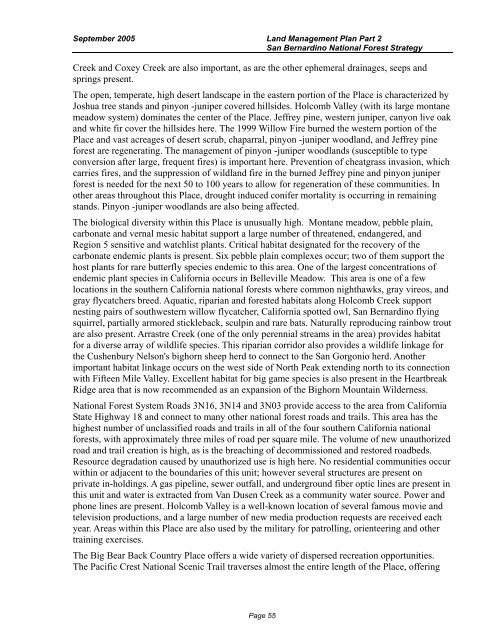San Bernardino National Forest Land Management Plan - Part 2
San Bernardino National Forest Land Management Plan - Part 2
San Bernardino National Forest Land Management Plan - Part 2
Create successful ePaper yourself
Turn your PDF publications into a flip-book with our unique Google optimized e-Paper software.
September 2005 <strong>Land</strong> <strong>Management</strong> <strong>Plan</strong> <strong>Part</strong> 2<br />
<strong>San</strong> <strong>Bernardino</strong> <strong>National</strong> <strong>Forest</strong> Strategy<br />
Creek and Coxey Creek are also important, as are the other ephemeral drainages, seeps and<br />
springs present.<br />
The open, temperate, high desert landscape in the eastern portion of the Place is characterized by<br />
Joshua tree stands and pinyon -juniper covered hillsides. Holcomb Valley (with its large montane<br />
meadow system) dominates the center of the Place. Jeffrey pine, western juniper, canyon live oak<br />
and white fir cover the hillsides here. The 1999 Willow Fire burned the western portion of the<br />
Place and vast acreages of desert scrub, chaparral, pinyon -juniper woodland, and Jeffrey pine<br />
forest are regenerating. The management of pinyon -juniper woodlands (susceptible to type<br />
conversion after large, frequent fires) is important here. Prevention of cheatgrass invasion, which<br />
carries fires, and the suppression of wildland fire in the burned Jeffrey pine and pinyon juniper<br />
forest is needed for the next 50 to 100 years to allow for regeneration of these communities. In<br />
other areas throughout this Place, drought induced conifer mortality is occurring in remaining<br />
stands. Pinyon -juniper woodlands are also being affected.<br />
The biological diversity within this Place is unusually high. Montane meadow, pebble plain,<br />
carbonate and vernal mesic habitat support a large number of threatened, endangered, and<br />
Region 5 sensitive and watchlist plants. Critical habitat designated for the recovery of the<br />
carbonate endemic plants is present. Six pebble plain complexes occur; two of them support the<br />
host plants for rare butterfly species endemic to this area. One of the largest concentrations of<br />
endemic plant species in California occurs in Belleville Meadow. This area is one of a few<br />
locations in the southern California national forests where common nighthawks, gray vireos, and<br />
gray flycatchers breed. Aquatic, riparian and forested habitats along Holcomb Creek support<br />
nesting pairs of southwestern willow flycatcher, California spotted owl, <strong>San</strong> <strong>Bernardino</strong> flying<br />
squirrel, partially armored stickleback, sculpin and rare bats. Naturally reproducing rainbow trout<br />
are also present. Arrastre Creek (one of the only perennial streams in the area) provides habitat<br />
for a diverse array of wildlife species. This riparian corridor also provides a wildlife linkage for<br />
the Cushenbury Nelson's bighorn sheep herd to connect to the <strong>San</strong> Gorgonio herd. Another<br />
important habitat linkage occurs on the west side of North Peak extending north to its connection<br />
with Fifteen Mile Valley. Excellent habitat for big game species is also present in the Heartbreak<br />
Ridge area that is now recommended as an expansion of the Bighorn Mountain Wilderness.<br />
<strong>National</strong> <strong>Forest</strong> System Roads 3N16, 3N14 and 3N03 provide access to the area from California<br />
State Highway 18 and connect to many other national forest roads and trails. This area has the<br />
highest number of unclassified roads and trails in all of the four southern California national<br />
forests, with approximately three miles of road per square mile. The volume of new unauthorized<br />
road and trail creation is high, as is the breaching of decommissioned and restored roadbeds.<br />
Resource degradation caused by unauthorized use is high here. No residential communities occur<br />
within or adjacent to the boundaries of this unit; however several structures are present on<br />
private in-holdings. A gas pipeline, sewer outfall, and underground fiber optic lines are present in<br />
this unit and water is extracted from Van Dusen Creek as a community water source. Power and<br />
phone lines are present. Holcomb Valley is a well-known location of several famous movie and<br />
television productions, and a large number of new media production requests are received each<br />
year. Areas within this Place are also used by the military for patrolling, orienteering and other<br />
training exercises.<br />
The Big Bear Back Country Place offers a wide variety of dispersed recreation opportunities.<br />
The Pacific Crest <strong>National</strong> Scenic Trail traverses almost the entire length of the Place, offering<br />
Page 55
















